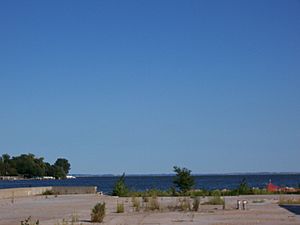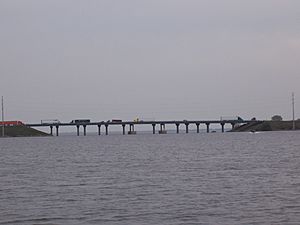Fox River (Green Bay tributary) facts for kids
Quick facts for kids Fox River |
|
|---|---|
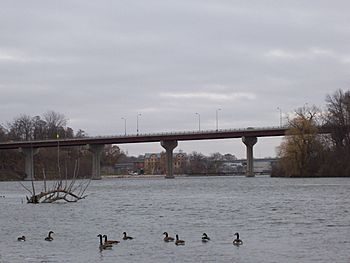
The Wisconsin Route 47 bridge
over the Lower Fox River in Appleton |
|
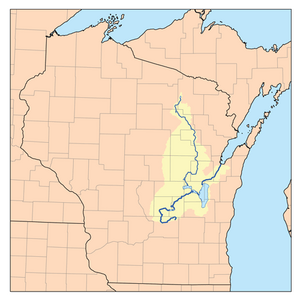
Map of the Fox River watershed showing the Fox (lower and right) and Wolf (higher) rivers
|
|
| Country | United States |
| State | Wisconsin |
| Physical characteristics | |
| Main source | Near Friesland 890 ft (270 m) 43°36′54″N 89°04′05″W / 43.615°N 89.068°W |
| River mouth | Green Bay / Lake Michigan 577 ft (176 m) 44°32′24″N 88°00′18″W / 44.54°N 88.005°W |
| Length | 200 mi (320 km) |
| Basin features | |
| River system | St. Lawrence River system |
| Basin size | 6,429 sq mi (16,650 km2) |
| Tributaries |
|
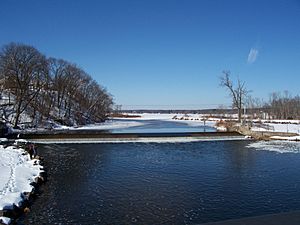
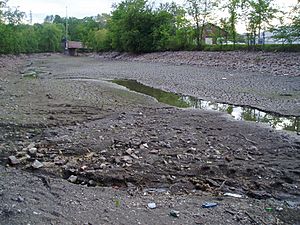
The Fox River is an important river in eastern Wisconsin, a state in the United States. It flows into Green Bay, which is part of Lake Michigan. The famous city of Green Bay is located right where the river meets the bay.
Scientists divide the Fox River into two main parts. The Upper Fox River starts in south-central Wisconsin and flows northeast into Lake Winnebago. The Lower Fox River then flows from Lake Winnebago northeast all the way to Green Bay. Together, these two parts make the Fox River about 200 mi (320 km) long.
The river's name comes from a French name, Rivière aux Renards, which means "River of the Foxes." This name was given by early explorers because the river flowed through the land of the Meskwaki people, who were called "Renards" (Foxes) by the French.
Contents
Where Does the Fox River Flow?
The Fox River has a long and interesting path through Wisconsin. It starts as a small stream and grows as it travels.
The Upper Fox River
The Upper Fox River begins near Pardeeville. It flows west and then turns north, coming very close to the Wisconsin River near Portage. After passing Montello, the river heads northeast until it reaches Lake Butte des Morts. Here, another river called the Wolf River joins it. The Upper Fox then flows into the west side of Lake Winnebago at Oshkosh. This part of the river is about 142 mi (229 km) long.
The Lower Fox River
The Lower Fox River starts at the northern end of Lake Winnebago. It flows north past cities like Neenah, Menasha, and Appleton. This section is about 40-mile (64 km) long and drops about 164 ft (50 m) in height. Before dams were built, this part of the river had many fast-moving rapids. The Lower Fox River finally ends when it flows through the city of Green Bay and into Green Bay, which is part of Lake Michigan.
River System and Water Flow
The Fox River and its connected Wolf River form a large watershed. This area covers about 6,429 sq mi (16,650 km2). This means all the rain and snow that falls in this large area eventually flows into the Fox River. On average, the Fox River sends about 4,132 cubic feet of water per second into Green Bay.
- Some rivers that flow into the Fox River include:
- East River
- Fond du Lac River
- Wolf River
- White River
- Mecan River
- Grand River
- Montello River
Cities Along the River
Many cities and villages are located along the banks of the Fox River. These communities have grown thanks to the river's resources.
- Cities on the Upper Fox River include:
- Oshkosh (near Lake Winnebago)
- Cities and villages on the Lower Fox River are often called the "Fox Cities":
- Farther north along the Lower Fox River, closer to Lake Michigan, are:
A Look Back in Time
The Fox River has been important for thousands of years. Long before Europeans arrived, Native American cultures lived along its shores. They used the river for fishing, hunting waterfowl, gathering wild rice, and for travel.
Early European Exploration
The first Europeans to explore the Fox River were the French. In 1634, explorer Jean Nicolet was one of the first. Later, in 1673, explorers Jacques Marquette and Louis Jolliet canoed up the river. They then carried their canoes a short distance to the Wisconsin River. This created an important water route between the Great Lakes and the Mississippi River, known as the Fox–Wisconsin Waterway. Native Americans likely used this route for trade long before.
The River's Industrial Past
In the 1800s, people tried to make the Fox-Wisconsin Waterway a major shipping route. They built locks and dams on the Fox River. They also dug a canal to connect it to the Wisconsin River. However, the Upper Fox River was often too shallow for large ships. Also, the river would freeze for many months each year.
Instead, the Lower Fox River became a center for industry. Many paper mills were built along the river. These mills used the river's strong water power and the large amounts of timber from nearby forests. Famous paper companies like Kimberly-Clark started here. Even today, the Lower Fox River is a major area for paper production. There are many paper mills that employ thousands of people.
Protecting the River
For a long time, the many paper mills and other industries along the Lower Fox River caused a lot of pollution. Waste from the mills was sometimes put into the river. This made the water unhealthy.
Cleaning Up the Fox River
In 1972, a law called the Clean Water Act was passed. This law helped start efforts to clean up rivers across the country, including the Fox River. Since then, a lot of work has been done to make the Fox River cleaner.
One big problem was with certain chemicals that settled at the bottom of the river. To fix this, a process called dredging began in 2009. Dredging means carefully removing the dirty mud and chemicals from the riverbed. Another method called capping was also used. This involves covering the contaminated areas with clean material to trap the chemicals. These cleanup efforts are still ongoing.
Some of the contaminated material from the river bottom was used to create an island called Renard Isle, also known as Kidney Island. This island was specially built to hold the material safely.
Wildlife and Recreation
Today, the Fox River is home to various wildlife. You can see birds like mallard ducks and Canada geese. Fish like walleye also live in the river.
The Fox River is also a great place for fun activities!
- The Fox River State Recreational Trail is a popular place for biking, walking, jogging, and rollerblading. Part of the trail is paved, and another section allows horseback riding.
- The Wiouwash State Trail also runs along the Fox River for a few miles near Oshkosh.
- Fishing is a big activity on the Fox River. Even though there were times when pollution affected fish, efforts to clean the river have helped. The Fox River has even produced state records for catching certain types of fish, like Striped bass and Shortnose gar.
Images for kids



